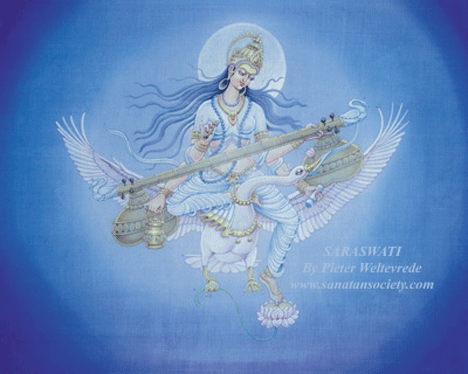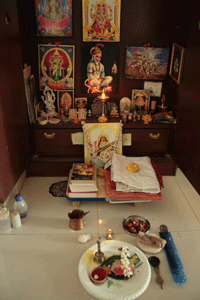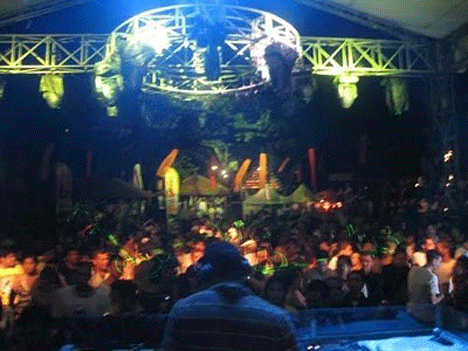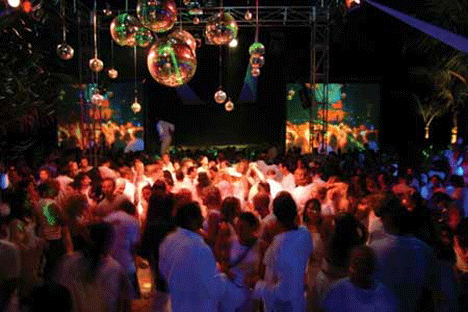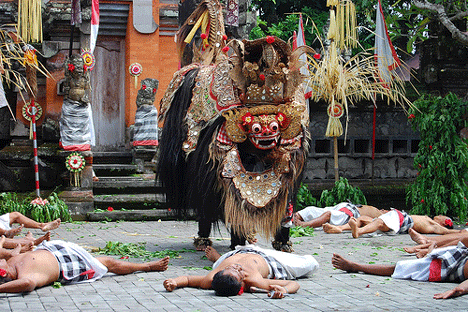A straight forward battle between good and bad : The
Barong dance is the classic story of good (the Barong) triumphing over evil (the witch Rangda).
The villages of
Batubulan as well as
Tegaltamu and
Singapadu, small towns located 30 minutes from
Denpasar, are known for putting on the best performances. There is, however, more to the Barong dance than the folkloristic dimension. It is, in fact, an integral part of the island's culture and has an evident sacred connotation. It isn't rare, in fact, to see the Balinese dancing the Barong during their religious ceremonies, regardless of the presence of tourists.
The
Barong is a strange creature, half shaggy dog, and half lion, propelled by two men like a circus clown-horse. The widow-witch
Rangda is bad though and certainly not the sort of thing you'd like to meet on a midnight stroll through the rice paddies.
The Barong dance is truly a triumphant display of bright colors and graceful movements.
Inspired by an episode taken from
Mahabharata, an epic poem written in
Sanskrit. The dance evolves around the character of the Barong, the king of the jungle. A mythical animal, he is the symbol of virtue and good, subject to the continuous struggle against the evil forces that threaten life and the integrity of the forest, this being an element very dear to the Balinese population.
In detail, the Barong embodies everything that can be beneficial to man, and help him defeat illness; black magic and any other kind of misfortune. The evil entity against which he must relentlessly fight is personified by
Rangda, queen of death and devourer of children. She is characterized by a dark and gloomy mask from which a red tongue of fire hangs. The entire dance is centered on the struggle between these two rival characters.
The Barong is interpreted by two dancers whose rhythmic movements bring to life the beautiful and elaborate costume they wear. A large animal head skillfully carved out of wood, brightly colored in red, white, black and gold. It is adorned with a crown extending outwards from the sides of the head, and by a prominent necklace which hangs from the neck, the final touch of the costume is a tail made out of bison leather which is elaborately finished and quilted.
The first character to appear on the stage is the Barong with his swaying gait: his dance is meant to express the joy of living. He is followed by a group of armed supporters who stand ready to defend him.
When Rangda strikes her terrible blows, it isn't at all rare for the dancers playing the Barong's followers to become so engrossed in the sacredness of the performance that they go into a real trance. A cloud of characters surround the Barong on stage. Rangda, goddess of death, personification of evil, the young girl servant
Kalika;
Dewi Kunti, queen of the kingdom of
Hastina and her stepson
Sadewa who will be sacrificed in order to placate the anger of Rangda, the minister Dewi Kunti;
Patih who expresses sorrow for the fate of Sadewa (Rangda will have to enter his soul in order to make him accept the sacrifice), and then the monkey supporters of the Barong, producers of palm tree wine (nira).
The end of the Barong dance is like an entirely separate performance. Also known as the
Kriss dance, it is named after the famous Males dagger. The idea is based on the philosophical concept
Rwa Bhineda : good and bad, evil and goodness which have always been present and have always existed together albeit in a constant and inevitably un resolved conflict.
Nothing will change in the future. While man is left free to try to develop his positive attitudes and let them win over the negative ones, he must nonetheless resign himself to the fact that the presence of both good and evil is a law of nature and as such must be accepted.
When the dance is performed, Rangda is the evil spirit which enters the bodies of his victims and pushes them to the edge of suicide. The dancers are armed with a
kriss. Rangda insults Barong and taunts the men- enraged and in a trance they attack her! But her powers are so strong that they are knocked out. When they come to they are so distressed by their failure that they try to impale themselves on their kriss. But their trance state amazingly protects them from injury.
Somebody can die or get seriously injured in a Barong dance. It is said that if Rangda's spell is too strong, a weak soldier may not be able to resist it, even with the help of Barong. He may end up hurting himself with his own kriss.
A very important element in the entire dance is the large orchestra, known as
gamelan, which is essential to underscore the ritual nature of the performance. Many are the instruments that make up the orchestra: some metal xylophones which stand out not only because they are so numerous but because of their powerful and imperious sound; there are also drums as well as flutes, the
rebab (a type of violin) and the gender (typical xylophones). All together, these instruments are essential in guiding the dance and underscoring the rhythm of well coordinated movements. These along with the joyful colors are the most alluring elements of this remarkable performance.
At the end of the dance, the masks of the Barong and of Rangda, as proof of their sacred nature, are stowed in a special room inside the
temple. They are covered very carefully, especially Rangda's mask, because its deadly powers are greatly feared. It's a way of saying that the ritual victory of the Barong, that is of good, which marks the end of the dance, is only temporary: tomorrow the eternal and unresolved conflict could begin again.
The masks of Barong and Rangda are considered sacred items, and before they are brought out, a priest must be present to offer blessings by sprinkling them with holy water taken from Mount Agung, and offerings must be presented.
More info :
Continue to read...
 Literally the word Pagerwesi means 'iron fence' - pager (fence) and wesi (iron) - and reflects the purpose of this important event: it is the day to strengthen one's fortifications against evil. The correlation between Pagerwesi and the Saraswati Day is that knowledge is so powerful that it must be protected from the bad influences. Pagerwesi Day reminds people to be wise and more aware of the function and power of knowledge.
Literally the word Pagerwesi means 'iron fence' - pager (fence) and wesi (iron) - and reflects the purpose of this important event: it is the day to strengthen one's fortifications against evil. The correlation between Pagerwesi and the Saraswati Day is that knowledge is so powerful that it must be protected from the bad influences. Pagerwesi Day reminds people to be wise and more aware of the function and power of knowledge.




